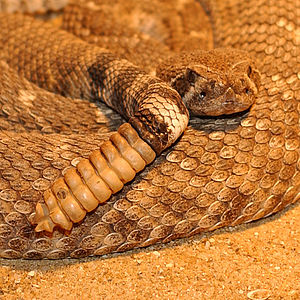Texas rattlesnake
| Texas rattlesnake | ||||||||||||
|---|---|---|---|---|---|---|---|---|---|---|---|---|

Texas rattlesnake ( Crotalus atrox ) |
||||||||||||
| Systematics | ||||||||||||
|
||||||||||||
| Scientific name | ||||||||||||
| Crotalus atrox | ||||||||||||
| Baird & Girard , 1853 |
The Texas rattlesnake , also known as western diamond rattlesnake ( Crotalus atrox ) is a species of rattlesnake that is found in the southwestern United States and northern Mexico . With a maximum length of over two meters, it is one of the largest rattlesnake species, alongside the diamond rattlesnake ( C. adamanteus ).
features
The Texas rattlesnake reaches a body length of 1.20 to 1.80 meters, in exceptional cases it also exceeds 2.00 meters in length. The body color ranges from gray to a light pink, yellowish gray or brick red. It has diamond-shaped drawing elements (" diamonds ") on its back, but these are usually only a little darker than the basic color and often blur with it. The spots are usually demarcated by a row of white scales, but this may be missing or incomplete. Sometimes there are also darker spots on the sides. The head color corresponds to the basic color of the body, below the eye a darker stripe extends into the corners of the mouth, sometimes with additional light stripes above and below. As one of the main distinguishing features of the snake, the tail has four to six black and white bands, each of which is approximately the same width. Like all rattlesnakes, it has a noticeable tail rattle .
distribution and habitat
The Texas rattlesnake is native to the southwestern United States and northern Mexico from Baja California to the Gulf of Mexico in Texas . It can also be found on some islands in the Gulf of California .
It lives mainly in very dry habitats in forests, deserts and prairies . These areas are characterized by very sparse vegetation and rocky soil. As a rule, the species lives in the lowlands, but can also be found in some areas at altitudes above 2,000 meters. This species is also found quite frequently in dry river beds or on roads.
Way of life
Like most other species of rattlesnakes, this species is also primarily active at night and at dawn and lives exclusively on the ground. It feeds mainly on small mammals , more rarely on lizards or birds, which it kills with its bite.
In the event of a potential threat, the snake tries to flee or behaves calmly and trusts its camouflage . If the threat becomes more intense, the snake can use its rattle as a warning, making a loud rattling noise. This is usually followed by a defensive bite, which is almost always associated with an injection of poison.
The viviparous Texas rattlesnakes give birth to between seven and 21 young snakes per litter, which are 30 to 36 centimeters long at birth.
Snake venom
As a large rattlesnake, the Texas rattlesnake also has a greater amount of venom than any other species in the genus with the exception of the diamond rattlesnake. The poison attacks the blood cells and destroys them, it also leads to tissue destruction in the area of the bite, which swells a lot. If left untreated, the bite can have very serious consequences for the patient and can even lead to death. From the venom of the rattlesnake five different metalliferous are toxins been isolated that its activity by removal of the metal by complexation with EDTA lose.
Antivenins , which can be used unspecifically for bites by rattlesnakes, are especially available for keeping in terrariums . A well-known preparation is "CroFab (Crotalidae Polyvalent Immune) [Ovine]".
literature
- Chris Mattison: Rattlers! - A natural history of rattlesnakes. Blandford, London 1996. ISBN 0-7137-2534-6 .
- Dieter Schmidt: snakes. Biology, species, terraristics. bede-Verlag Ruhmannsfelden 2006. ISBN 3-89860-115-3 .
Web links
- Crotalus atrox in The Reptile Database
- Crotalus atrox inthe IUCN 2013 Red List of Threatened Species . Posted by: Frost, DR, Hammerson, GA & Santos-Barrera, G., 2007. Retrieved September 17, 2013.
Individual evidence
- ↑ W. Kaim / B. Schwederski, Bioinorganische Chemie, Teubner Study Books, 1995, ISBN 3-519-13505-1 , p. 261

